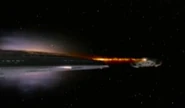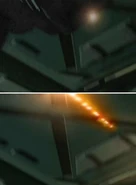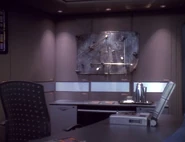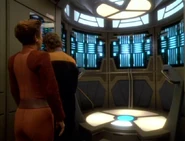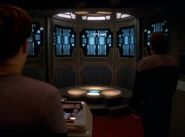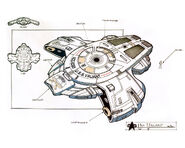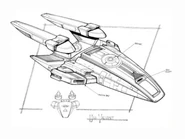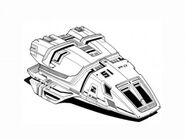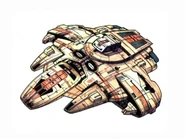 |
Warning! This page contains information regarding Star Trek: Lower Decks, and thus may contain spoilers.
|
The Defiant-class battleship, officially an escort vessel, began development in 2366 as a small, highly powered, heavily armed warship intended to defend the United Federation of Planets against the Borg. The USS Defiant (NX-74205) was the prototype of what was to be a new Federation battle fleet. However, the ship had numerous design problems that were made apparent during its shakedown cruise. These flaws, combined with the decreased urgency of the Borg threat, caused Starfleet to table its plans for a battle fleet and put the Defiant in storage. (DS9: "The Search, Part I")
The Defiant prototype was pulled out of storage in 2371 when the Dominion threat emerged. After several upgrades by Deep Space 9 Chief of Operations Miles O'Brien, the ship was subsequently deemed worthy of use and more ships of the class were constructed. (DS9: "The Search, Part I", "Call to Arms"; VOY: "Message in a Bottle")
History
While Starfleet had participated in numerous battles and engagements in its history, it had largely fought those battles with the ships they had available. The Defiant-class starship was a heavily armed, limited-role vessel: the first true "warship" Starfleet had ever designed.
It was developed in response to the Borg threat as originally encountered at System J-25 in 2365. (TNG: "Q Who") After initial and hostile first contact with the Borg, Starfleet did what it hadn't done in decades, place greater emphasis on defense of the Federation, including the incorporation of war game exercises. (TNG: "Peak Performance") Likewise, Starfleet Tactical threw every resource it had into the project, where it drafted plans for weapon system designs capable of fighting against the Borg. (TNG: "The Best of Both Worlds")
In 2366, Starfleet also began to explore the possibility of building a new class of starship that had no families, no science labs, no luxuries of any kind, and existed simply to "to fight and defeat the Borg". (DS9: "The Search, Part I") By mid-year, Commander Elizabeth Shelby had taken over the tactical analysis aspect of the entire project, and over a year after initial contact, the majority of Starfleet's new designs were still on the drawing board and at least twenty-four months from completion. (TNG: "The Best of Both Worlds") Shortly after the massacre at Wolf 359, Lieutenant Commander Benjamin Sisko joined the development team at the Utopia Planitia Fleet Yards and the prototype was built. (DS9: "The Search, Part I")
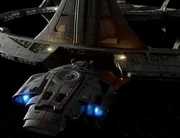
The USS Defiant docked at Deep Space 9
The Defiant-class was heavily armored and incorporated the latest in Starfleet weaponry and defensive technology along with a class-7 warp drive. The Defiant was considerably smaller than most other Federation starships. Despite the ship's compact size, she was packed to the brim with equipment designed for larger starships. (DS9: "The Search, Part I")
The prototype Defiant performed poorly on its shakedown cruise. The vessel was overpowered and overgunned for a ship of its size; so much so that the Defiant nearly shook itself apart when the engines were tested at full power. These design flaws, combined with the decreased urgency of the Borg threat, led Starfleet to abandon the project and put the prototype away in storage. (DS9: "The Search, Part I")
The Dominion threat discovered in 2370 led Benjamin Sisko, now the commanding officer of starbase Deep Space 9, to pull the prototype vessel out of storage. The ship was assigned to his station, and it was officially christened that same year on Stardate 47538.5. The prototype was then equipped with a Romulan cloaking device, the only Federation starship to possess such technology as the result of an amendment to the Treaty of Algeron. (DS9: "The Search, Part I") Thanks to the efforts of Chief O'Brien, many of the original ship's design flaws, such as its structural integrity field, were fixed. (Defiant dedication plaque; DS9: "Shattered Mirror")
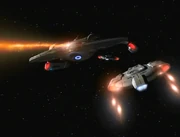
Two Defiants and an Akira-class battle the Romulans
At some point, Starfleet eventually decided to put the Defiant class into full production. By the end of 2373, there were a significant number of Defiant-class ships in operation, and over the next two years, they played a vital role in the Dominion War. (DS9 Season 7; VOY: "Message in a Bottle", "Endgame")
Commenting on the appearance of additional Defiant-class ships appearing in "A Call to Arms", Ronald D. Moore said, "We just decided that the Fed was now cranking out Defiant-class vessels based on Sisko's recommendations to SF Command." (AOL chat, 1997)
In 2373, the USS Defiant was given a chance to do what it had been designed for when it participated in the Battle of Sector 001, where a Federation fleet engaged a single Borg cube on its way to assimilate Earth.
As the cube approached Earth, the Defiant, under the command of Lieutenant Commander Worf, was disabled by a tractor beam strike after having sustained massive battle damage. With the ship's main power and defensive systems offline, Worf prepared to ram it into the Borg cube when the USS Enterprise arrived to assist the tattered Federation fleet. As the Enterprise entered the battle, the Defiant lost life support after sustaining another hit from the Borg tractor beam, and the survivors were transported onboard the Enterprise. Shortly after the Borg cube was destroyed, Captain Picard noted that the Defiant, despite being adrift, was salvageable. (Star Trek: First Contact)
The USS Defiant was destroyed by a Breen interceptor in 2375, during the Second Battle of Chin'toka. Another Defiant-class ship, the USS Sao Paulo, was then assigned to Deep Space 9. Given the USS Defiant's exceptional record under Captain Benjamin Sisko's command, the Chief of Starfleet Operations gave a special dispensation to change the ship's name to Defiant. On this ship, the shield generators were completely reconfigured so that they would not be affected by the Breen's energy-dampening weapon. However, unlike the original Defiant, this ship was not equipped with a cloaking device. This new Defiant played a distinguished role in the final battle with the Dominion at Cardassia Prime and remained stationed at Deep Space 9 by the end of 2375. (DS9: "The Changing Face of Evil", "The Dogs of War", "What You Leave Behind")
Schematics of the ship were also part of the standard library computer, with images of the class appearing in the LCARS files of the USS Voyager and the holographic files of the USS Protostar. (VOY: "Drone", "The Voyager Conspiracy"; PRO: "Starstruck")
In 2382, the Anaximander was under the command of Captain William Boimler, an agent of Section 31 who was investigating the quantum fissures with the help of a crew of "interdimensional castaways." (LD: "Fissure Quest")
In 2384, ships of this class were among the fleet that intercepted the Protostar in a restricted sector near Gamma Serpentis. (PRO: "Mindwalk")
Eighteen ships of this class participated in Frontier Day celebrations over Earth in 2401. (PIC: "Võx", "The Last Generation")
Knowledge of this class was retained well into the 31st century, as demonstrated when Captain Jonathan Archer and Lieutenant Malcolm Reed viewed schematics on the class in the 22nd century while accessing the database belonging to temporal agent Daniels. (ENT: "Shockwave")
Technical data
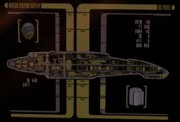
MSD of the Defiant-class
Propulsion systems
The warp core spanned three decks in the aft section of the ship. The class-7 warp drive was extremely powerful for a ship of this size, and as such, Defiant-class vessels put out a warp signature equivalent to much larger starships. (DS9: "The Search, Part I", "One Little Ship") The propulsion systems of the Defiant-class were overpowered for her size, to the extent that the original configuration would rip the ship in half if run above warp 9. (DS9: "The Sound of Her Voice") This flaw contributed to the mothballing of the prototype. (DS9: "The Search, Part I") Despite this issue being resolved after the prototype was deployed to DS9, some ships produced later, such as the USS Valiant, still suffered from similar issues. (DS9: "Valiant") When energy was diverted from the weapons' ready reserves, a Defiant-class ship could achieve the speed of warp 9.5. (DS9: "The Sound of Her Voice")
The large power signature of the engines proved taxing for the USS Defiant's cloaking device and remaining concealed initially required stopping and powering down the ship, although this issue was later addressed. (DS9: "The Search, Part I", "The Way of the Warrior", "Trials and Tribble-ations")
In the first draft script of "The Dogs of War", the Defiant-class was established as being capable of warp 9.8.
According to the Star Trek: Deep Space Nine Technical Manual (p. 153), the Defiant-class was rated for a maximum output of warp factor 9.982 for twelve hours.
Tactical systems
Phaser cannons
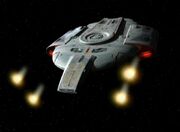
Defiant-class phaser cannons
A total of four phaser cannon assemblies were located in forward-facing locations on board Defiant-class vessels. The cannons were located above and below the nacelle root attachments on the main body on both port and starboard sides of the ship. The plasma conduit ran through the primary phaser coupling, almost doubling the power of the phaser cannons. (DS9: "The Search, Part I", et al.)
These cannons had a much higher damage output compared to standard phasers. (DS9: "Defiant", "Favor the Bold", "Sacrifice of Angels", "Tears of the Prophets")
Phaser emitters
The standard phaser beam emitters aboard Defiant-class vessels served as a secondary supplement to the primary phaser cannon array. The Defiant-class was equipped with at least three emitters: one each forward and aft, as well as one behind the bridge on the dorsal surface. (DS9: "Paradise Lost", "Shattered Mirror", "The Emperor's New Cloak"; VOY: "Message in a Bottle") These arrays were included to allow the Defiant to engage multiple targets simultaneously, protect against enemies to the rear, and to allow it to perform strafing runs, all of which could not be accomplished by the forward-facing phaser cannons. (DS9: "The Way of the Warrior", "Rules of Engagement", "Sacrifice of Angels"; Star Trek: First Contact)
The Defiant-class vessels' deflector arrays could also be refitted into a makeshift phaser emitter, providing one-shot capability in extreme emergency. The phaser emission was generated by the nose/deflector unit. (DS9: "Starship Down")
Torpedo launchers
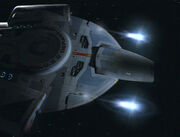
The USS Defiant firing quantum torpedoes
Defiant-class vessels had a total of six torpedo launchers, four forward and two aft. The four forward launchers were located on the hull just ahead of each of the warp nacelles in dorsal and ventral pairs. (DS9: "Defiant", "For the Uniform") The two aft torpedo launchers were tucked in near the back end of the warp nacelles. (DS9: "The Die is Cast", "Paradise Lost") These torpedo launchers allowed the ship to fire both quantum torpedoes and photon torpedoes. (DS9: "Defiant", "The Adversary", etc.)
Mines
While it was presumably never intended, the Defiant-class shuttle bay could be converted to allow the ship to lay mines. (DS9: "Call to Arms")
Deflector shields
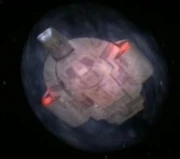
The shields of a Defiant-class
The Defiant-class was equipped with deflector shields.
During the Dominion War, after the destruction of the first USS Defiant, the Federation fleet was modified to be immune to Breen energy-dampening weapon technology. (DS9: "The Dogs of War")
Ablative armor
At least one Defiant-class vessel, the experimental prototype, was equipped with ablative armor. (DS9: "The Way of the Warrior") As late as 2372, Starfleet Operations had not been informed that the Defiant had been so equipped. (DS9: "Paradise Lost")
Cloaking device
A special amendment to the Treaty of Algeron allowed the USS Defiant to be fitted with a Romulan cloaking device. (DS9: "The Search, Part I", "Defiant")
The Romulans loaned and allowed the limited supervised use of at least one cloaking device. Operation of the cloaking device was to be limited to the Gamma Quadrant and in return, the Federation provided the Romulans any and all intelligence collected in the Gamma Quadrant and about the Dominion. (DS9: "The Search, Part I", "Visionary") The USS Defiant was the only Federation ship to be seen regularly operating a cloaking device. (DS9: "The Search, Part I")
It is of note that soon after the cloaking device was brought into use, the Dominion developed a way to penetrate the cloak using certain types of antiproton beams. The Defiant was especially vulnerable as the power of the warp engines in relation to the size of the ship led to a high-power signature that wasn't fully masked by the cloaking device. It did, however, at times provide a significant tactical advantage that was exploited on numerous occasions. This issue was later resolved, indicating that a modification was developed to defeat this detection method.
After the Defiant was destroyed by the Breen, her replacement, the former USS Sao Paulo, was not equipped with a new cloaking device. (DS9: "The Dogs of War")
At least one of the Defiant-class vessels operated by Section 31 is equipped with a cloaking device. (LD: "Crisis Point 2: Paradoxus")
Interior design

Decks 2, 3, and 1 (left to right)
Due to the militaristic nature of the Defiant-class starship, the interior design was the most spartan in Starfleet. With her role as a warship first and foremost, the Defiant eschewed most of the typical living, recreational and leisure amenities enjoyed on typical Starfleet vessels. The ship possessed no holodecks, no lounges or recreation centers, no arboretums, no accommodations for families or civilians; the ship's mess hall was small and doubled as its sole informal meeting venue.
The Defiant class had four decks.
- Deck 1: main bridge, captain's ready room, |Transporter Room 1, phaser cannons (2), upper main engineering, plasma exhaust vents, upper sensor array, officer and crew quarters, deuterium storage. (DS9: "The Search, Part I", "Rejoined", "To the Death", "Starship Down", "The Sound of Her Voice")
- Deck 2: lower main engineering, main impulse engines, computer core, targeting sensors, mess hall, warp coils, sickbay, medical and science laboratory, Transporter Room 2, officer and crew quarters, warhead control room. (DS9: "Defiant", "The Adversary", "Nor the Battle to the Strong", "Starship Down")
- Deck 3: main impulse engines, warhead impulse engines, Shuttlebays 1-3, antimatter storage, cargo bays 1-4, airlocks (2), aft torpedo magazine, warp coils, shuttle and cargo management unit maintenance. (DS9: "The Ship", "The Sound of Her Voice")
- Deck 4: landing struts, navigational deflector, phaser cannons (2), forward and aft torpedo magazines, aft torpedo launchers (2), forward torpedo launcher (1), lower sensor array, Shuttlebay 1-2 exterior doors and elevator system, main tractor beam emitter. (DS9: "Trials and Tribble-ations", "One Little Ship")
Doug Drexler based the deck plans in the Star Trek: Deep Space Nine Technical Manual (foldout) on his master systems display, seen in "The Adversary" and many later episodes. A "Deck 5" was mentioned in dialogue three times during the fourth season: in "The Way of the Warrior", "Rejoined" and "To the Death". The first two citations were in reference to hull breaches; the third had Captain Sisko traveling to "Deck 5, Section 1" via turbolift.
Main bridge
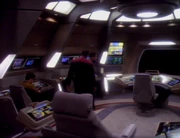
The Defiant bridge in early 2371
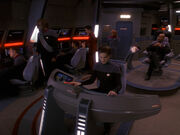
The bridge in 2373, after having undergone a partial redesign later in 2371
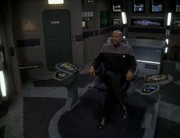
The bridge of the second USS Defiant, featuring different furnishing and a new aft console
The bridge layout of the Defiant was compact, but nonetheless accommodated the familiar engineering, tactical, science, conn, and ops stations.
The main bridge acted as the nerve center of the vessel, and the entire module was sunken into a much larger Deck 1 than on most Federation starships to provide added protection during combat situations. Access to the bridge was provided by two doorways at the back, located on both port and starboard sides. Just forward of the starboard entryway was the location of the ship's dedication plaque, as well as an auxiliary computer access panel.
The port side of the bridge housed the engineering and tactical I stations, while the starboard side featured the science and tactical II consoles. Because of its nearly exclusive role as a combat vessel, stations aboard Defiant-class vessels were designed with speed in mind.
The center of the bridge featured the lone captain's chair, which was on a raised platform and had a clear view of all bridge stations, as well as of the main viewscreen. On both sides of the captain's chair were separate control panels, allowing the occupant access to virtually every system aboard the ship.
Between the command chair and the viewscreen was an integrated flight control and operations panel, capable of performing the joint duties of those stations' larger counterparts on other Federation starships. Like all of the bridge stations on Defiant, the conn had been designed for maximum speed and efficiency of commands input by the operator, allowing the craft to be handled almost like a fighter when under the hands of a skilled pilot.
The engineering station allowed for a direct link to the impulse and warp engines, as well as monitoring of the other various systems vital to the operation of the ship. This single station was capable of mirroring all the readouts and consoles located in main engineering, allowing the chief engineer or another engineering officer to issue commands from the bridge.
Mirroring the engineering station on the port side of the bridge was the science station. Normally occupied by the ship's chief science officer, the panels and readouts on this station allowed direct access to the ship's sensor systems. While the ship was not built for scientific or exploration missions in mind, it was capable of taking high resolution scans of both natural and artificial phenomena, engaging in scientific investigation; this station played a vital role during reconnaissance missions.
Flanking both sides of the viewscreen were two tactical stations, which had primary access to the ship's powerful phaser cannons, torpedo launchers and various other special ordnance packages. Working closely with conn, the officers stationed at these consoles were responsible for firing the various weapons aboard Defiant-class vessels during combat operations. The purpose of the tactical II station was to lighten the load on its sister station, particularly in battle.
Some time after the commission of the Defiant-class in 2371, various aspects of the bridge were redesigned. The captain's chair area was redone to remove the fencing and add new consoles, the dedication plaque was moved to the starboard door area, and additional consoles were added to the side stations and the rear wall. (DS9: "Equilibrium")
Some time in 2373, Starfleet vessels were fitted with new holo-communicator technology. A holographic projector on the bridge could create a holographic simulation of the communique. (DS9: "For the Uniform") This technology was only briefly in service, as it proved inefficient and had minimal advantages compared to communicating via viewscreen.
Medical facilities
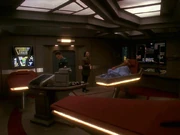
The Defiant sickbay
The main sickbay was located on Deck 2 between the mess deck and science labs. Containing four biobeds, this room served as the primary crew support facility during emergency situations. The room was equipped with limited surgical facilities and was primarily intended merely to stabilize patients until they could be delivered to a nearby friendly Starbase medical facility.
In its limited role as a reconnaissance starship, the Defiant-class was equipped with two dedicated science and medical labs for field testing and investigations. These rooms mirrored their counterparts on larger Federation starships by making use of scaled down devices that could commonly be found on those ships. (DS9: "Broken Link")
Main engineering

Main engineering on a Defiant-class vessel
Main engineering on the Defiant-class was situated on Deck 1 with the lower section on Deck 2. The Master Situation Monitor was located in the starboard wall bulkhead. The warp core was placed on an elevated platform in the center of the compartment, opposite the control consoles. Ships of the Defiant-class were equipped with a class-7 warp drive.
At the end of DS9 Season 5, the Defiant-class engineering set was deemed to be taking up much-wanted room in the swing set area of the Paramount sound stages used by Star Trek: Deep Space Nine. This resulted in the set for an overhead flying rig – originally built and used for Season 2 installment "Melora" – to be removed from that stage. (Star Trek: Deep Space Nine Companion, p. 95)
Crew berthing
Overall, crew quarters aboard Defiant-class vessels were the most austere in Starfleet, neither sizeable nor aesthetically laid-out when compared to other ships in the fleet. In keeping with its tactical layout, accommodations were simplistic. Each cabin was equipped with one replicator port and one standard computer terminal.
With emphasis towards the tactical systems being the foremost priority in the vessel designers' minds, crewmembers had to share their quarters with at least one other crewmate during normal times of operation. To this end, standard crew quarters had two stacking bunks fitted into the walls of each cabin. Only the ship's commanding officer was given his own room on Deck 1, which doubled as an informal ready room.
Mess deck

Mess hall
Ships of the Defiant-class lacked any sort of recreational facilities, and the only place for informal gathering were the two mess deck areas located on the port side of Deck 2. Like all the rooms and materials aboard the ship, the mess deck was compact and functional. At the head of the room were three open slots that served as dispensers for the replicators. A counter extended from the underside and was used for the placement of trays, mugs and eating utensils. Seating inside the mess deck was provided by four metallic tables arranged in a semicircle at the wider end of the room. These tables were approximately one meter square, and each had four stools connected to its legs. In addition, the mess deck doubled as a makeshift meeting area that could be used to conduct crew briefings and mission profiles. A tall screen panel located on one of the walls could be used as a visual aid to display tactical graphics. (DS9: "Valiant")
Transporter rooms
Defiant-class ships were equipped with two transporter compartments, one located on Deck 1 and the other on Deck 2. Again, the compact nature of the Defiant-class meant the transporter pads were much smaller than the sort found on Galaxy-class and Intrepid-class starships and could not accommodate as many people at one time. (DS9: "Past Tense, Part I", "The Die is Cast", "The Way of the Warrior")
Cargo hold
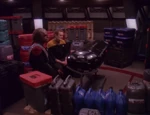
Cargo hold
The cargo hold was where the ship's supplies were kept. (DS9: "The Ship")
This location was identified in the episode's script
Ships in class
- Named
- Terran
- Unnamed
Appendices
Appearances
- DS9:
- "The Search, Part I"
- "The Search, Part II"
- "Equilibrium"
- "Second Skin"
- "Meridian"
- "Defiant"
- "Past Tense, Part I"
- "Past Tense, Part II"
- "Destiny"
- "Improbable Cause"
- "The Die is Cast"
- "The Adversary"
- "The Way of the Warrior"
- "The Visitor"
- "Rejoined"
- "Starship Down"
- "Our Man Bashir"
- "Paradise Lost"
- "Sons of Mogh"
- "Bar Association"
- "Rules of Engagement"
- "Shattered Mirror"
- "For the Cause"
- "To the Death"
- "Broken Link"
- "The Ship"
- "Nor the Battle to the Strong"
- "Trials and Tribble-ations"
- "The Ascent"
- "The Darkness and the Light"
- "For the Uniform"
- "In Purgatory's Shadow"
- "By Inferno's Light"
- "Soldiers of the Empire"
- "Children of Time"
- "Blaze of Glory"
- "In the Cards"
- "Call to Arms"
- "A Time to Stand"
- "Sons and Daughters"
- "Behind the Lines"
- "Favor the Bold"
- "Sacrifice of Angels"
- "You Are Cordially Invited"
- "The Magnificent Ferengi"
- "Waltz"
- "Far Beyond the Stars"
- "One Little Ship"
- "Honor Among Thieves"
- "Inquisition"
- "Valiant"
- "Profit and Lace"
- "Time's Orphan"
- "The Sound of Her Voice"
- "Tears of the Prophets"
- "Image in the Sand"
- "Once More Unto the Breach"
- "The Siege of AR-558"
- "Covenant"
- "It's Only a Paper Moon"
- "Prodigal Daughter"
- "Field of Fire"
- "Chimera"
- "Badda-Bing, Badda-Bang"
- "Penumbra"
- "The Changing Face of Evil"
- "The Dogs of War"
- "What You Leave Behind"
- TNG films:
- VOY:
- ENT: :
- "Shockwave" (digital image)
- PIC:
- "The Next Generation" (display graphic)
- "The Bounty"
- "Võx"
- LD: :
- PRO:
- "Starstruck" (digital image)
- "Mindwalk"
- "Supernova, Part 1"
- "Supernova, Part 2"
Background information
According to Ronald D. Moore the Defiant did not have a detachable saucer section. (AOL chat, 1997)
Design
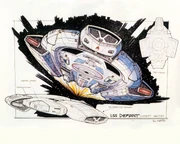
Defiant-class concept art
In the final draft script for "The Search", the physical appearance of the Defiant-class was initially described thus; "The ship should look a little clunky compared to other Federation vessels we've seen – this ship was built primarily for battle, not exploration or science." [1]
The Defiant-class was designed by James Martin under the direction of Herman Zimmerman and Gary Hutzel.
According to Martin, the initial instruction for the designers was that it was a "beefy runabout." His initial designs based upon this guideline, however, were not accepted by the producers. Martin next turned to more traditional starship designs, but Zimmerman told him that a completely new look was needed, like nothing ever seen on Star Trek before.
Ultimately, Martin went to a design he had done for a Maquis fighter for the episode "The Maquis, Part II", and he brought it to the producers, who approved it as the basis for the Defiant-class. After tweaking the design a little, Martin gave the schematic to model maker Tony Meininger who, along with his Brazil Fabrications, was given the nod to bring the design to life.
The main problem with the design at that stage was that it didn't look fast enough, so Meininger, a car enthusiast, got some posters of Ferraris and used them to help him design the "streamlined" look of the ship, making it very compact and sleek.
Indeed, Herman Zimmerman has stated that the compact design of the Defiant-class influenced the design of Enterprise NX-01 for Star Trek: Enterprise. He also pointed out, "It was very clear it could not look like NCC-1701-A, B, C, D. It was to be an entirely new ship." (The USS Defiant, DS9 Season 3 DVD special features; Star Trek: The Magazine Volume 1, Issue 4; Star Trek: The Magazine Volume 1, Issue 13; Star Trek: Communicator issue 105)
The CGI Defiant, as it appeared in First Contact, was built by Vision Art and rendered by Industrial Light & Magic.
For DS9, a digital model of the Defiant was built by Digital Muse, which was then borrowed by the visual effects artists of Star Trek: Voyager, as and when required. (Cinefantastique, Vol. 30, No. 9/10, p. 80) A CGI Defiant was also used in DS9's title sequence.
Stock visual effects shots were used for both the prototype USS Defiant and its substitute. (Star Trek: Deep Space Nine Companion, p. 701)
The studio model of the Defiant, measuring 37" × 27", was sold at the 40 Years of Star Trek: The Collection auction on 6 October 2006 for US$85,000 (US$102,000 with buyer's premium). [2](X) Additionally, several white foam core camera test models were sold on It's A Wrap! sale and auction, selling at prices ranging from US$27.00 to US$384.00. [3](X) Several pieces of Martin's revised sketches of the Defiant, dated 24 November 1994, were also sold on It's A Wrap!, for US$502.00. [4](X)
Size
According to Hutzel, during the early development stages of the ship, the Defiant was to be "a new hot battleship that would really set a new standard for an action ship in the series. First, there was lots of talk like 'How big is the Defiant?' Well, we'll make it really small and really powerful, that it would be so powerful and scary, nobody would mess with it." (USS Defiant, DS9 Season 3 DVD special features)
According to Doug Drexler, "The size of the Defiant was a hot potato from day one. Rick Berman wanted a small pocket battleship (a couple times longer than a runabout, with the girth of a regular starship), Gary wanted at least 500' [152.4 m]." [5](X)
The scale of the CGI mesh, according to a post in the newsgroup nntp://alt.tv.star-trek.ds9, by DS9 Visual Effects Supervisor David Stipes, was 560 feet (170.7 meters), the length used when he blocked shots in DS9. This was also the size established in the Star Trek: Deep Space Nine Technical Manual (p. 153).
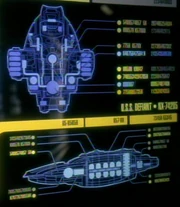
MSD depicting early design for the Defiant-class
The original MSD that appeared in "The Search, Part I" actually depicted an early concept design and did not represent the final iteration. was later replaced with an accurate MSD in such episodes as "Shattered Mirror", although it was used on displays until the end of Deep Space Nine. Drexler, who was responsible for creating the ship's MSD, rationalized "a 420′ [128.0 m] Defiant." [6](X)
For further analysis on the Defiant's scaling, visit the "Defiant Problems" link at Ex Astris Scientia below.
Designation
Initial drawings described the class as the Valiant-class. Indeed, Drexler even constructed an initial dedication plaque for the Defiant that referred to it as the "Valiant-class," before a new plaque was recreated that simply stated, "the first ship of her class." The plaque was later given to Rob Bonchune. [7] Bruce Branit also once referred to the class as "the Valiant-class." (Cinefantastique, Vol. 30, No. 9/10, p. 64)
Interior
The interior sets of the Defiant were supervised by Herman Zimmerman. (citation needed • edit)
According to regular background performer Brian Demonbreun, there were special carpets transferred onto the "normally" seen carpet of the Defiant in scenes including explosions and sparks. All actors, mostly the background performers, who were near those sparks were made wet, with a light moisture film on their hair and uniform. (citation needed • edit)
When it came time to film DS9 Season 3 premiere "The Search, Part I", the relatively small set used as the Defiant challenged the production crew, who had transferred to DS9 from TNG. (Captains' Logs Supplemental - The Unauthorized Guide to the New Trek Voyages, p. 82) They began to find design flaws as soon as they started filming on the new set. "Initially, it was very hard to shoot in the Defiant set," confirmed Director Kim Friedman. (Star Trek: Deep Space Nine Companion, p. 163) David Livingston added that this was "because we hadn't been in there a lot, and it's cramped; any time you shake the camera or move the camera it takes a lot more time." (Captains' Logs Supplemental - The Unauthorized Guide to the New Trek Voyages, p. 82) With the floor of the Defiant's bridge including a central raised platform under the command chair and a frontal raised platform beneath the helmsman's station, the filming workers discovered the bridge, whose layout was permanent, didn't allow for sufficient room to lay a dolly track, which restricted the camera movements. The tight physical restrictions influenced Friedman to watch old World War II films involving "people sitting in cockpits," in an effort to increase her familiarity with methods employed when shooting in constrained places. Another issue was that, since the cloaking device was initially only meant to be used during the "The Search" two-parter, the set was not made with variable lighting; all the light bulbs had to be manually changed (by stopping filming) whenever the cloak was used. When the cloak was kept, this made filming nightmarish and reshoots an exercise in hurry up and wait. Subsequent alterations to the Defiant bridge set made it a lot easier to film in. (Star Trek: Deep Space Nine Companion, p. 163)
DS9 Season 3 finale "The Adversary" introduced a Defiant-class engine room and mess hall, which were created as standing sets. "What we did is we amortized the set costs in our amortization account since they're permanent sets," explained David Livingston. Ronald D. Moore was highly pleased with the addition of the new sets. (Captains' Logs Supplemental - The Unauthorized Guide to the New Trek Voyages, p. 99)
The same sets were used for both the Defiant and the Valiant. (Star Trek: Deep Space Nine Companion, p. 572) However, these interiors were intentionally not used for the USS Bellerophon in DS9: "Inter Arma Enim Silent Leges" (which instead became an Intrepid-class ship, permitting the use of the standing sets for Star Trek: Voyager). "We could have reused the Defiant sets once again [as in "Valiant"], saying the Bellerophon was a Defiant-class ship, but I didn't want to," Ron Moore recalled. (Star Trek: Deep Space Nine Companion, p. 662) Elaborating on why he opted not to reuse the Defiant-class sets for the Bellerophon, Moore critiqued, "It's always a little bit of a push with the audience when you are doing that, because they know what you are doing. They know you are just using the same sets again, and it gets a little boring." (Cinefantastique, Vol. 32, Nos. 4/5, p. 76)
Technical Manual
The Nova-class was later designed based on the configuration of the Defiant "Pathfinder" vehicle, registry NXP-2365WP/T, included in the Star Trek: Deep Space Nine Technical Manual. [8](X)
The following details and specifications come from the Star Trek: Deep Space Nine Technical Manual (p. 153):
Specifications
- Production Base: ASDB Integration Facility, Antares Fleet Yards, Antares IV
- Type: Escort
- Accommodation: 40 officers and crew; 150 personal evacuation limit
- Power Plant: One 1,500 plus Cochrane warp core feeding two nacelles; two impulse modules
- Dimensions: Length, 170.68 meters; beam, 134.11 meters; height: 30.1 meters
- Mass: 355,000 metric tons
- Performance: Warp 9.982 for 12 hours
- Armament: Four pulse phaser cannons; two torpedo launchers
Warhead
The notched forward hull containing the vessel's navigational deflector and main sensors was a detachable single-use last-resort missile. This missile was equipped with a small impulse engine and a magazine with six torpedo warheads. These torpedo warheads were part of the ship's auto-destruct system and under more normal circumstances could be fired from the forward launcher. Any torpedo warheads left in the magazine would become the missile's warhead upon the missile's separation from the rest of the ship. If no torpedo warheads remained, then the missile would have to rely on kinetic energy alone. The ship would be unable to travel at high warp speeds without the missile since the latter contained the ship's navigational deflector. (Star Trek: Deep Space Nine Technical Manual, pp. 132, 134)
Apocrypha
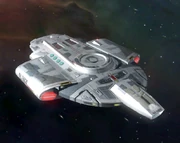
The Defiant-class in Star Trek: Legacy
During the mission "Ambush" in the game Star Trek: Legacy, the USS Defiant was sent to the Etarian Nebula for a test flight of its systems, where the crew found that the Romulans had invaded the nebula waiting for a fugitive. The USS Enterprise-D was sent to rescue the Defiant with three other starships and to neutralize any Romulan threat remaining.
The William Shatner series of novels featured another Defiant-class vessel, the USS Monitor (β). The Monitor boasted several modifications from a standard Defiant-class starship, such a cloaking device and black sensor reflective hull plating. Its warp engines were tuned so the nacelles would emit ultraviolet light instead of the standard red and blue, and the ship had no running lights or hull markings. In Shatner's novel The Return, the Monitor is temporarily renamed Enterprise during a mission to the Borg homeworld using a stolen transwarp drive, commanded by Captains Kirk, Picard, and Spock.
The Decipher role-playing supplement Starships lists many other conjectural vessels of this class including the USS Gallant (β) (NCC-74206), USS Incessant (β) (NCC-75636), USS Redoubtable (β) (NCC-75634), and USS Stalwart (β) (NCC-75635).
Star Trek Online has Defiant-class vessels available for characters who reach Captain rank or higher as a Tier 4 "Tactical" Escort or Tier 5 "Tactical Escort Retrofit" (the difference being that the Tier 5 variants come equipped with cloaking devices). Other Tier 4 escorts are meant as late 24th and early 25th descendants of the Defiant class, sharing its basic profile – these include the Vigilant (β) class and Gallant (β) class Tactical Escorts. It also has a refit version called the Sao Paulo-class (β) "Tactical Escort Refit" with quad phaser cannons. The game features two NPC Defiant-class starships, the USS Defiant and the USS Belfast (β).
In both Star Trek: Armada and Star Trek: Armada II the ship, in particular the Avenger, carries antimatter mines.
A Defiant-class starship appeared as an escort in the video game Star Trek: The Next Generation - Birth of the Federation.
The Defiant-class is playable in multiplayer and skirmish modes in the PC and Xbox 360 video game Star Trek: Legacy.
Star Trek: Armada II features the following possible names for Defiant-class starships:
|
|
|
|
External links
- Defiant class at Memory Beta, the wiki for licensed Star Trek works
- Defiant class starship at Wikipedia
- Defiant Problems at Ex Astris Scientia: a comprehensive look at the scaling issues of the Defiant-class
- Jim Martin Interview; Designing the USS Defiant(X) - an article by Jim Martin taken from the Star Trek: The Magazine Volume 1, Issue 4 (August 1999) and Star Trek: The Magazine Volume 1, Issue 13 (May 2000)
- USS Defiant at Cygnus-X1.net, the Star Trek LCARS Blueprints Database
- Designing the Defiant at StarTrek.com

